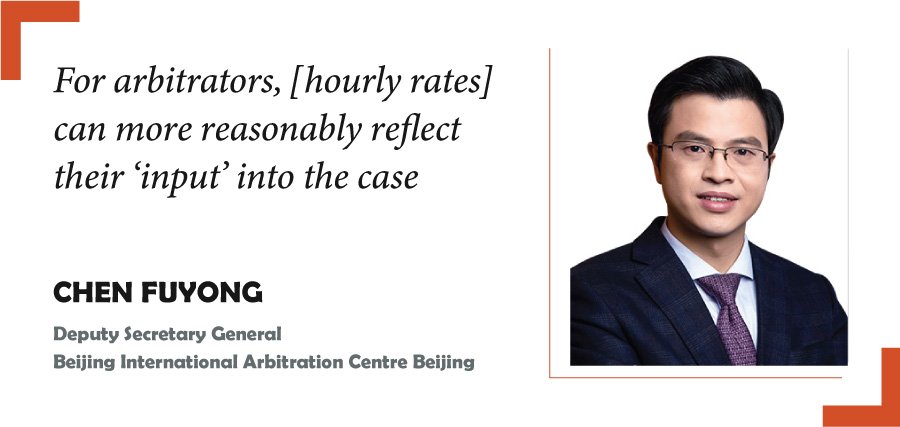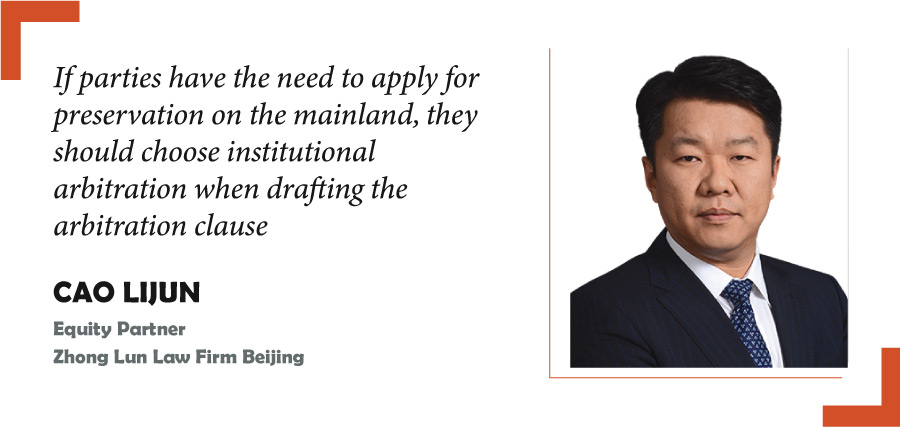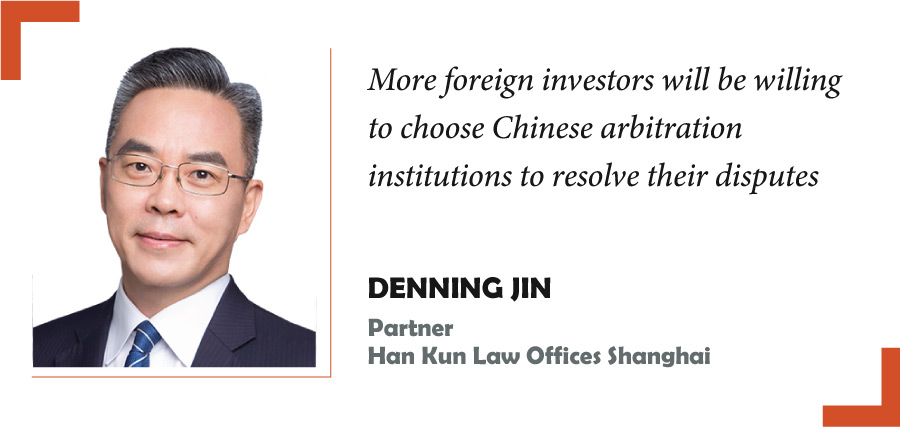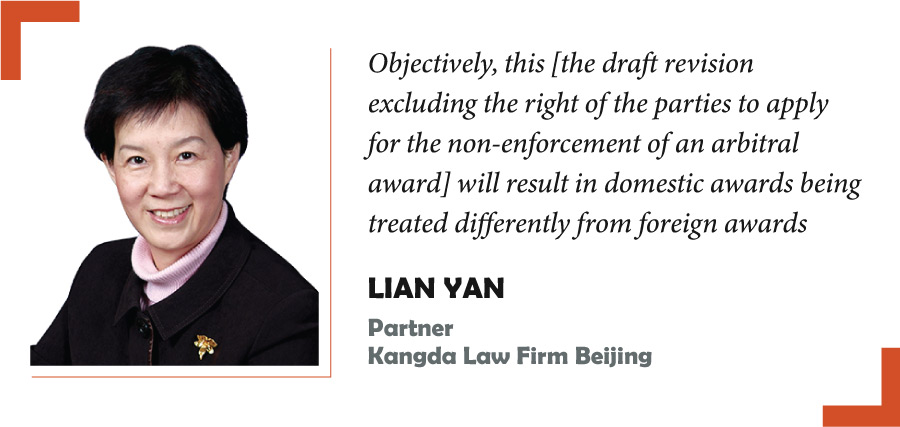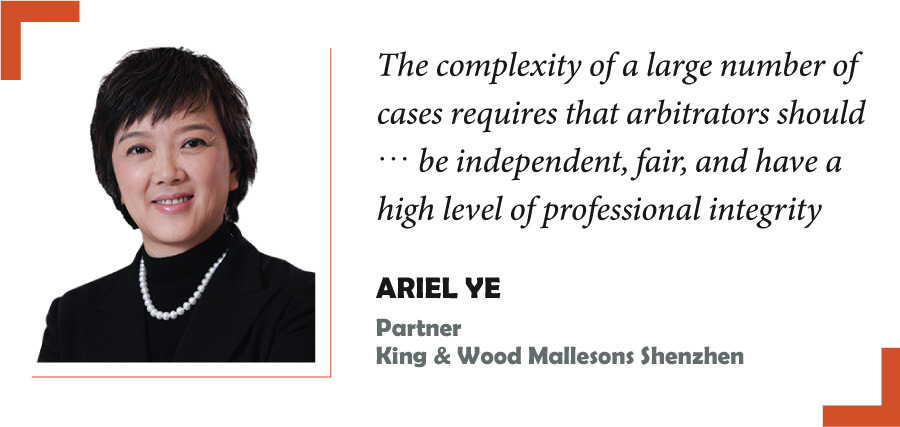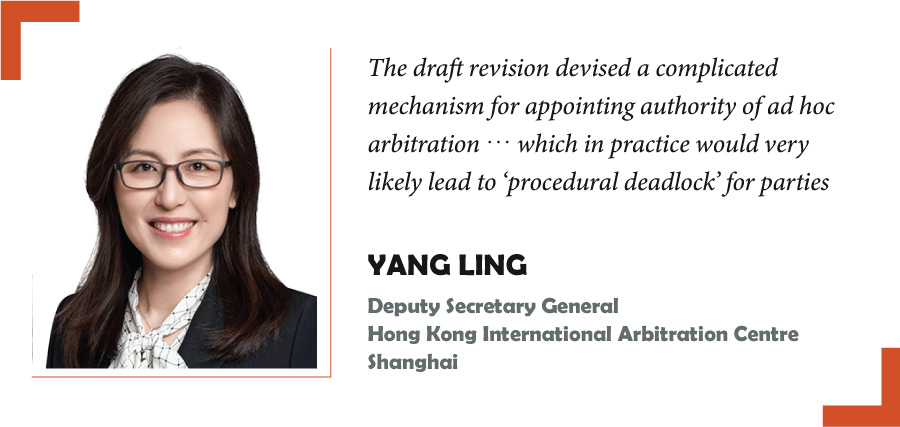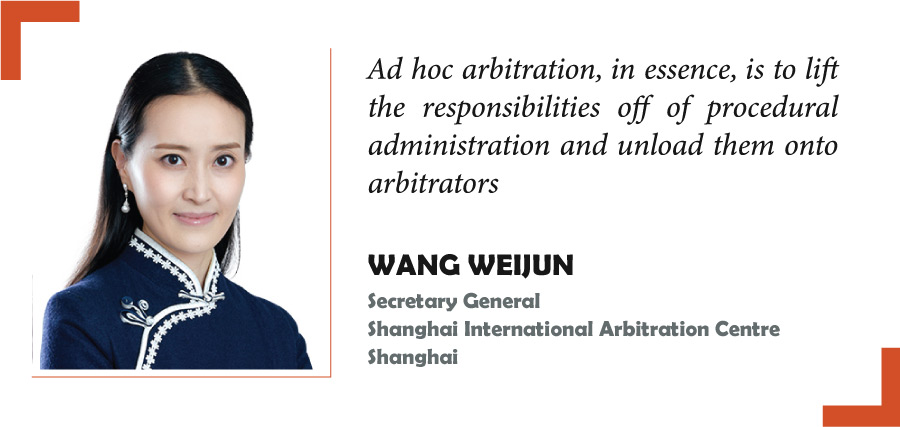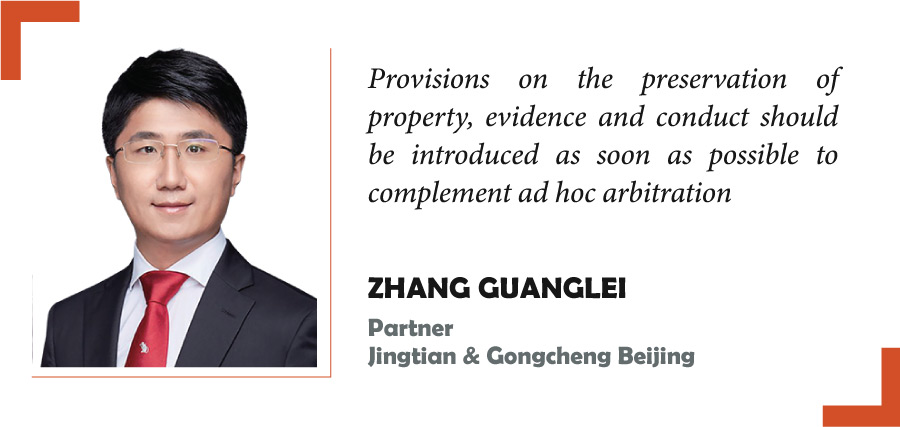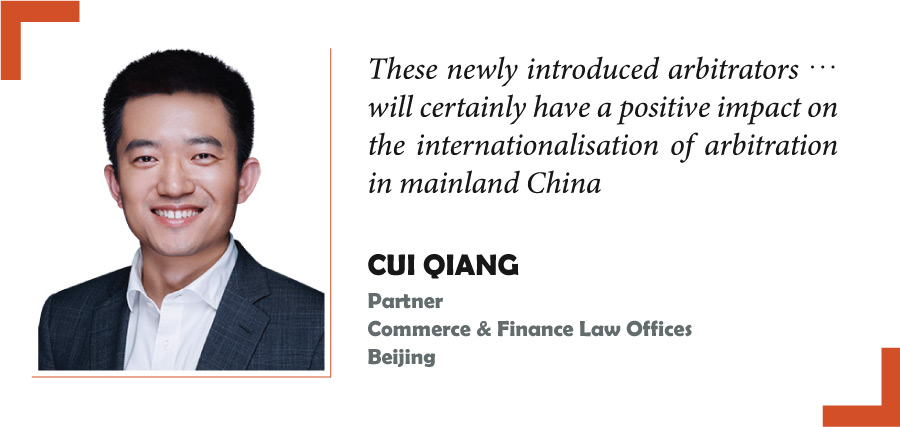Amendments to key legislation may make China a Model Law country to the greatest extent possible, but will that be enough for the dispute resolution sector to be considered truly international? Luna Jin reports
The many changes in China’s dispute resolution arena have recently demonstrated unprecedented breadth and ambition. On the legislative front, the draft revision of the Arbitration Law, published in July this year, is the first major amendment in its true sense since the law’s implementation in 1995.
For litigation cases in areas such as corporate, contracts, guarantees, finance and bankruptcy, Chinese courts are working to implement judicial reforms to unify judicial approaches. In the area of arbitration, domestic and offshore institutions are continuing to introduce various measures to facilitate parties.
Institutional support
Cao Lijun, a Beijing-based equity partner at Zhong Lun Law Firm, summarises the developments made by mainland arbitration institutions in recent years in terms of systems and procedures, “mainly about how to streamline the procedural aspects of arbitration filing, serving a process and hearings through online platforms and web-based technology, in order to efficiently facilitate the progress of arbitration proceedings”.
The China International Economic and Trade Arbitration Commission (CIETAC), Beijing International Arbitration Centre (BAC), Shanghai International Arbitration Centre (SHIAC) and Shenzhen Court of International Arbitration (SCIA) have all issued guidelines on online hearings and fee waivers to help cope with the pandemic.
Wang Weijun, secretary general of the SHIAC, notes that since 2020 the institution has organised more than 50 online hearings, mediations and testimonials, including many cases where the parties and the tribunal were from different time zones.
In order to help aviation enterprises, which were severely affected by the pandemic, resume work and production, the SHIAC established a green channel for aviation disputes. By September this year, the two cases received were both successfully concluded.
In terms of fee arrangement, this year the BAC became the first mainland arbitration institution to formally adopt hourly rates for arbitrators’ fees. Chen Fuyong, deputy secretary general of the BAC, says: “For arbitrators, [hourly rates] can more reasonably reflect their ‘input’ into the case; for the parties, they are now more in a position to directly influence and control costs.”
Previously, in September 2019, the BAC introduced a then-new fee arrangement that transformed the division of fees from “processing fee” and “handling fee” to “arbitrator’s fee” and “administration fee”.
Behind the shift in the fee arrangement is a revamp of the fundamental positioning of arbitration institutions in mainland China. Apart from the BAC’s reform, the SCIA has also established a non-profit corporate governance structure led by a council.
Zhu Huafang, a Beijing-based partner at TianTong Law Firm, says these changes attest to “the deepening reform of the de-administration and governance structure of mainland arbitration institutions”. In the past, these institutions were heavily “administrative”, as their legal attributes were not clear in legislation and they were formed by government organs.
Mainland institutions have also made efforts in going international by bringing in international arbitrators. The panels of arbitrators updated this year by the CIETAC, BAC and SHIAC include a large number of foreign arbitrators. Cui Qiang, a Beijing-based partner at Commerce & Finance Law Offices, says: “These newly introduced arbitrators have extensive international arbitration experience and will certainly have a positive impact on the internationalisation of arbitration in mainland China.”
Among the various initiatives, Cao, of Zhong Lun, believes that one of the highlights this year is the “the Co-operation Mechanism of the Beijing Joint Declaration of the Belt and Road Arbitration Institutions”. Spearheaded by the CIETAC, the mechanism was jointly reached by 32 overseas arbitration institutions and organisations, and 15 domestic arbitration institutions.
Cao says that this will promote co-operation among arbitration institutions, and innovation and development of alternative dispute resolution through the mutual nomination of arbitrators.
In the Queen Mary University of London’s annual survey of international arbitration released this year on 7 May, the CIETAC was ranked fifth among the world’s most popular arbitration institutions, following the ICC International Court of Arbitration, Singapore International Arbitration Centre, Hong Kong International Arbitration Centre (HKIAC) and London Court of International Arbitration.
This was the first time an arbitration institution from mainland China had been ranked in the top five.
In contrast, the practice of offshore institutions has long since moved beyond institutional preparation to focus on providing user-friendly tools and helping parties understand the basis and rules of the arbitration awards.
Yang Ling, deputy secretary general of the HKIAC and its chief representative in Shanghai, says that this year the institution launched two powerful tools – Case Connect and Case Digest. Case Connect is a communication platform used by parties, the arbitral tribunal and the secretariat, serving as a repository to which all documents (including the parties’ written pleadings and the tribunal’s orders) may be uploaded, through which users can access the applicable arbitration rules, or track deadlines and dates on a case-specific calendar. Case Digest is an archive of anonymised and summarised procedural decisions taken by the HKIAC under various procedural rules.
Radical legislative changes
The draft revision of the Arbitration Law published this year – considered by many in the industry as a clear move towards the UN Commission on International Trade Law’s (UNCITRAL) Model Law on International Commercial Arbitration – incorporates a large amount of practical arbitration experience, and mature and feasible judicial interpretations, and makes reference to the practices of international arbitration in many aspects.
Wang, of the SHIAC, points out that currently in the international arbitration community, whether a jurisdiction is a Model Law jurisdiction is an important indicator when evaluating its arbitration system.
“The only thing in the Model Law that was not included in the [Arbitration Law] draft revision was simply the provision on enforcement of arbitral awards,” she says. In particular, one of the major changes is the recognition of the concept of the seat of arbitration in the draft.
Under the current law, the criteria for determining the relevant arbitration matters are mostly determined by the place of the arbitral institution. Depending on the nationality of the arbitration award, Chinese laws provide for different procedures for the recognition and enforcement of domestic awards, foreign awards, and awards from Hong Kong, Macau and Taiwan.
The nationality of an award made by a foreign arbitral institution seated in China, if judged by the place of arbitration and the seat of the arbitral institution, respectively, would lead to very different conclusions.
Therefore, the draft allows parties to directly agree on the seat of arbitration in the arbitration agreement, in line with international practice, which will greatly facilitate the full compatibility of arbitration activities of foreign arbitral institutions in mainland China with China’s arbitration procedural laws.
The draft also allows the permanent body of foreign arbitration institutions to conduct foreign-related arbitration business on the mainland. Cao, of Zhong Lun, says: “This is equivalent to mainland China granting foreign arbitral institutions the same ‘national treatment’ as domestic arbitral institutions at the legal level.
“By setting up a presence in mainland China, foreign arbitral institutions can also further clarify issues such as the nationality of awards, jurisdictional courts, and so on,” he adds.
Zhang Guanglei, a Beijing-based partner of Jingtian & Gongcheng, stresses that, “the draft revision shows a shift in the approach to legislation by upholding party autonomy”. The draft removes the requirement for the arbitration agreement to include the “chosen arbitral institution” while recognising the doctrine of competence-competence, which is the power of an arbitration tribunal to rule on its own jurisdiction.
Denning Jin, a Shanghai-based partner at Han Kun Law Offices, expects that “the gaps between domestic and international arbitration practices will be narrower, and more foreign investors will be willing to choose Chinese arbitration institutions to resolve their disputes”.
However, the draft revision is not without limitations. For provisions concerning arbitration institutions, Chen, of the BAC, points out that some specific wordings and institutional arrangements could be further clarified. “For example, the draft revision does not specify the conditions for the establishment of arbitral institutions, which are still based on administrative divisions,” he says. “This is not in line with the characteristics of the private nature of arbitration and the market principles.”
Wang, of the SHIAC, suggests that the draft revision does not distinguish among “arbitral institutions”, “foreign arbitral institutions” and “business institutions established by foreign arbitral institutions in the territory of the People’s Republic of China”. The concepts of “other specialised organisations conducting arbitration” should also be further clarified.
For arbitration practice-related terms, the draft revision expressly excludes the right of the parties to apply for the non-enforcement of an arbitral award. “This may lead to the problem of inequality between parties in domestic and foreign arbitrations regarding the right to relief from an arbitral award,” notes Cao.
Under the current draft, parties to an offshore arbitration are entitled to a dual procedural remedy of both setting aside the arbitral award at the place of arbitration and not enforcing it under the New York Convention, says Cao, whereas parties to arbitration in mainland China have only the former.
Lian Yan, a senior partner at Kangda Law Firm in Beijing, agrees. “Objectively, this will result in domestic awards being treated differently from foreign awards,” she says.
Ariel Ye, a Shenzhen-based partner at King & Wood Mallesons, says the draft revision is not sufficiently clear and comprehensive as to the qualifications of arbitrators. “The complexity of a large number of cases requires that arbitrators should not only have extensive experience in arbitration, but also be independent, fair, and have a high level of professional integrity,” says Ye.
She therefore suggests that, drawing on international experience, a vocational training course for arbitrators should be completed in order to become an arbitrator. Such courses are offered by private institutions such as the Chartered Institute of Arbitrators and the Singapore Institute of Arbitrators.
What the draft also does not take into account is a provision on whether the respondent submits its defence and evidence on time. Ye points out that, in practice, in many arbitration cases the respondent completely ignores the time limit for submission of defence as stipulated in the arbitration rules, and the time limit for submission of defence materials by the arbitral tribunal, and submits written defence and evidence material only when the hearing is due to start, or even makes an oral defence during the hearing and makes submissions only after the hearing, resulting in the arbitral tribunal often being forced to hold a second hearing for this purpose.
In this regard, she suggests that the draft revision adds under the relevant article: “If the respondent fails to submit its defence within the prescribed time limit, the arbitral tribunal shall have the right to refuse to consider the respondent’s defence and evidentiary material.”
Court-ordered interim measures
It has been more than two years since the Arrangement on Mutual Assistance in Preservation between the Courts of the Mainland and the Hong Kong Special Administrative Region in respect of Arbitral Proceedings took effect. On 27 November 2020, the supplementary provisions to the arrangement were signed and came into full effect on 19 May 2021, in both places.
At present, a total of six arbitration institutions in Hong Kong, recognised by the Supreme People’s Court and the Department of Justice of Hong Kong, are eligible to apply to mainland courts for interim measures. “The current situation is that almost all applications from Hong Kong accepted by mainland courts come from the HKIAC,” says Wang, of the SHIAC.
Yang Ling says that, as of October this year, the HKIAC had received a total of 50 applications for asset preservation on the mainland involving 23 mainland courts. A total of 32 civil rulings have been made by these courts, 30 of which have upheld the parties’ applications, involving a total preservation amount of about USD1.7 billion.
“Since the Mainland-Hong Kong mutual preservation arrangement came into effect, it has played a positive role in facilitating parties to arbitration proceedings in both places to safeguard their rights, streamline the procedure and reduce dispute resolution costs,” says Zhu, of TianTong.
Wang believes that, on the whole, the arrangement is working well at present. However, for individual cases, the ability of parties to apply for “pre-arbitration preservation” under the arrangement is one of the unresolved issues, she says.
Cao points out that it is more difficult for Hong Kong parties to apply for pre-arbitration preservation in mainland courts, which are currently less receptive to such applications, than the “in-arbitration preservation”.
He notes a case where a mainland court rejected a Hong Kong company’s application for preservation on the basis that the arbitration initiated by the applicant in Hong Kong was an ad hoc arbitration. Therefore, “if parties have the need to apply for preservation on the mainland, they should choose institutional arbitration when drafting the arbitration clause,” cautions Cao.
In practice, Zhu advises that, due to the many differences between the preservation/interim measures on the mainland and in Hong Kong, “parties should pay extra attention to the rules and review criteria of the courts of the other place when applying for preservation”.
For example, the threshold for interim measures in Hong Kong courts is higher than the threshold for conservatory measures in mainland courts, and “mainland parties applying for interim measures in Hong Kong courts should attach importance to proving to the court the urgency of the case situation,” says Zhu.
There is also still a lack of reciprocity in the preservation procedures between the two places. Wang points out that mainland courts may allow parties to directly apply for preservation with supporting documents stamped by the Hong Kong arbitration institutions, but in the same situation, Hong Kong courts may require documents to be forwarded by the arbitration institutions for preservation application by mainland arbitration institutions.
Ad hoc uncertainty
One other significant upgrade in the draft amendment to the Arbitration Law is the introduction of ad hoc arbitration, a notable addition on top of institutional arbitration, which is currently the only form of arbitration permitted.
The Supreme People’s Court (SPC) had issued judicial interpretations as early as 2016 that substantially acknowledged the validity of ad hoc arbitration agreements, in support of innovative dispute resolution mechanisms in the pilot free-trade zones. It issued the Ad Hoc Arbitration Rules in the Hengqin Pilot Free Trade Zone in 2017, followed by opinions in 2019 and 2021 to explore new and diverse arbitration approaches in Lin-gang Special Area Administration of the Shanghai Free Trade Zone and the Hainan Free Trade Port, respectively.
Still, there is yet to be a single case where ad hoc arbitration was adopted. So, what has been stopping people from opting for ad hoc arbitration in China? Wang believes it comes down to two main issues – the legal system and talent reserve.
In the absence of support from the upper tier of China’s legal hierarchy, ad hoc arbitration is not strictly recognised by law, or supported by any system-based foundation. So, should the draft amendment be approved, will ad hoc arbitration be able to move forward unobstructed?
Wang believes otherwise. “Ad hoc arbitration, in essence, is to lift the responsibilities off of procedural administration and unload them onto arbitrators,” she says. “No doubt that time and experience will help arbitrators mature as administrators, but people will generally find the opportunity cost-lofty.” She expects that institutional arbitrators will maintain their dominance for some time to come.
Ad hoc arbitration to China is both new and foreign, and efforts must be made to cultivate the land in order for it to root and sprout, says Chen. “We must foster public trust towards ad hoc arbitration, establish the credibility of the new system,” he says.
He suggests that legislators must further refine the rules and regulations for ad hoc arbitration, and due judicial oversight should be in place to prevent arbitration fraud.
Court-ordered asset preservation would be very difficult under ad hoc arbitration on the mainland, says Zhang, of Jingtian & Gongcheng. “Provisions on the preservation of property, evidence and conduct should be introduced as soon as possible to complement ad hoc arbitration,” he says.
Apart from that, “the draft revision devised a complicated mechanism for appointing authority of ad hoc arbitration to facilitate the smooth conduct of proceedings, which in practice would very likely lead to ‘procedural deadlock’ for parties,” says Yang, of the HKIAC. In contrast, the Hong Kong Arbitration Ordinance directly authorises the HKIAC to deal with the constitution of the tribunal in ad hoc arbitrations, she says.
Ye, at King & Wood Mallesons, is of the opinion that the drawbacks for permitting ad hoc arbitration in the Arbitration Law outweigh the benefits. She observes that most parties in international arbitration opt for institutions, and that “the instances of parties choosing ad hoc arbitration are in decline”.
Additionally, where foreign affairs are concerned, Ye is doubtful that ad hoc arbitrators can competently perform all administrative functions borne by domestic arbitration institutions, including notice serving, document preservation, the convening of experts’ meetings, receipt of arbitration fees, and payment to arbitrators.
Determining direction
In the past year, trends and regulatory changes have been visibly reflected in the cases handled by law firms and main arbitration institutions. Among the cases handled by the BAC, disputes arising from sales contracts account for approximately one-fifth of the total. The dispute instances in sales contracts and construction project contracts recorded significant increases, up by 37{e421c4d081ed1e1efd2d9b9e397159b409f6f1af1639f2363bfecd2822ec732a} and 27{e421c4d081ed1e1efd2d9b9e397159b409f6f1af1639f2363bfecd2822ec732a} from last year, respectively.
Chen deduces that this development could be a result of the increased likelihood of disputes during the production, sale, export and logistics of goods since the covid-19 outbreak. The tightening-up of the banking sector also means fewer loans for property development, and less tolerance for certain developers.
Cui likewise senses a surge in sales contract disputes. His firm represented a great number of new energy-related lawsuits and arbitrations, which are closely linked to the soaring price of raw materials and costs of ocean shipping.
Capital market and investment and financing transactions have remained active. Wang observes the SHAIC still handles more cases related to the financial and capital markets than any other category. Among the arbitration cases accepted between 2018 and 2020, 43.5{e421c4d081ed1e1efd2d9b9e397159b409f6f1af1639f2363bfecd2822ec732a} involved arbitration cases concerning the financial and capital markets or equity investment or financing, accounting for 81.6{e421c4d081ed1e1efd2d9b9e397159b409f6f1af1639f2363bfecd2822ec732a} of the total amount in dispute. The average amount in dispute for these cases amounts to RMB38.5 million.
In light of the rise of cryptocurrencies, the SHIAC also handled numerous disputes involving crypto transactions.
The largest percentage of disputes handled by Cao during the year was for equity disputes, particularly related to entrusted shareholding or capital increase, or between investor and former shareholder relationship, or between the target company and/or the management. “With the pandemic continuing to loom over everything, sectors heavily reliant on offline activities, such as education and entertainment, are gravely challenged,” he says. “Consequently, target companies often cannot fulfil their performance commitments or meet the listing requirements, which trigger certain arrangements under the shareholder agreement, and a dispute is born.”
Cao further notices an upturn in insurance-related disputes, including domestic trade credit insurance and overseas investment insurance.
Security false statements are another increasingly disputed issue that are closely connected with changes in the judicial environment.
In the past, the Several Provisions on Trying Cases of Civil Compensation Arising from False Statement in Securities Market, promulgated by the SPC in 2003, has been the main basis for judgment in relevant cases. The provisions state that investors bringing a false statement lawsuit must be preceded by the administrative penalty or a criminal order. Recently, however, when the accused argue that they have not been subject to an administrative penalty, in the majority of cases, they no longer receive court support.
Cui, of Commerce & Finance, says that regulators and legislators are pushing forward a revision to this rule. “If the revised provision abandons the prepositive requirement for administrative penalty or criminal order, we will see a continued increase in false statement disputes, as well as cases where security service agencies are sued,” he predicts.
Another judicial document directly responsible for the increase in disputes is the Minutes of the National Working Conference on the Trial of Civil and Commercial Cases by Courts. Observing a significant increase in disputes related to trust products, Lian interprets it as a result of the SPC minutes, released by the SPC in November 2019, providing guidelines for the legality and validity of financial products.
The ruling opinions under the SPC Minutes have been subsequently further legitimised by the Civil Code, effective since 1 January 2021, leading to intensified supervisory efforts. The impact of the minutes goes far beyond this. According to court disclosures, Chinese courts at all levels have so far made reference to the minutes in more than 24,000 cases since its release. “The minutes are of great significance to Chinese courts in unifying their judgment approach in judicial practice,” says Cao.



